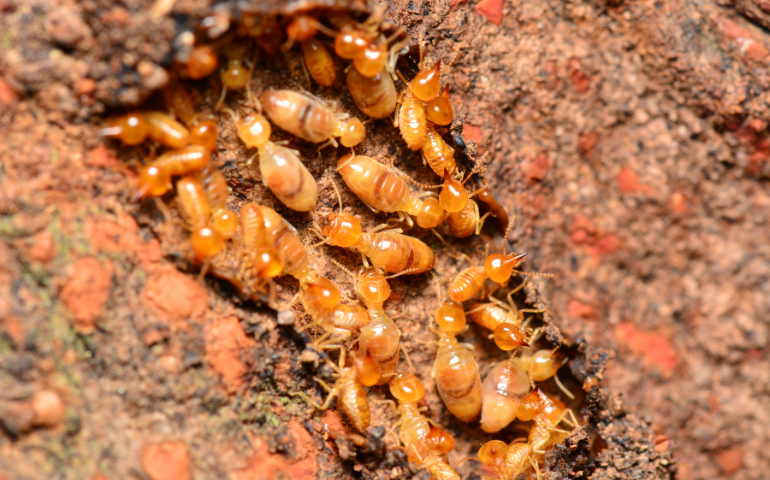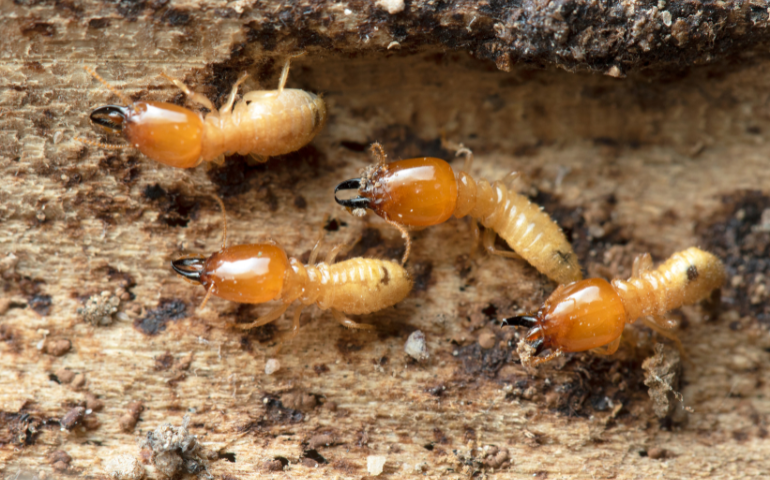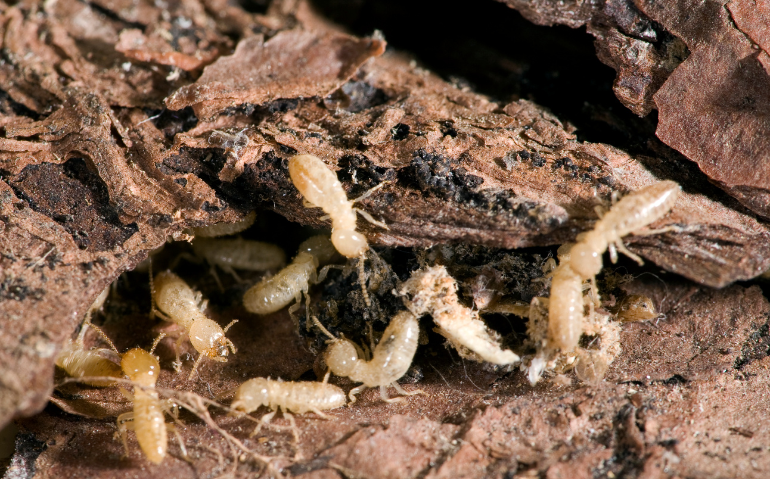Termites
Termites are small, social insects known for their wood-eating habits, which can cause significant damage to buildings and wooden structures. They typically range from 1/4 to 1/2 inch long and can be white, light brown, or dark brown. Termites are classified into three main types: subterranean, which live underground and build mud tubes; drywood, which infest dry wood without needing soil contact; and dampwood, which prefer moist, decaying wood. These pests have straight antennae, broad waists, and in the reproductive caste, wings of equal size.
Key Characteristics of Termites:
Social Structure:
Termites live in colonies, organized into different castes. The primary castes include workers, soldiers, and reproductives (alates or swarmers).
Diet:
Termites are cellulose-eating insects. They feed on wood, plant material, paper, and other cellulose-rich substances.
Life Cycle:
The termite life cycle involves egg, nymph, and adult stages. Colonies produce winged reproductives during specific times of the year for swarming and establishing new colonies.
Habitat:
Termites are highly adaptable and can be found in various environments. They often build nests underground, in soil, or within wooden structures.
Silent Invaders:
Termites are known as "silent destroyers" because they can cause extensive damage without immediate signs. Infestations often go unnoticed until structural damage becomes apparent.
What Kinds of Termites Are There?

Common in North America, Subterranean Termites build their nests underground. They create mud tubes to access above-ground food sources and are responsible for significant structural damage.

Typically found in damp and decaying wood, Damp Wood Termites are less common in homes. They prefer high-moisture environments and can infest wood that has been in contact with water.

These termites infest dry wood and do not require contact with soil. They can be found in structural timber, furniture, and other wooden items.
What Are The Signs Of A Termite Infestation?
Termite infestations can wreak havoc on your property, causing extensive damage and financial losses if left unchecked. Recognizing the early signs of a termite problem is crucial for prompt intervention and effective control. Here are some key indicators to watch for:
Mud Tubes:
Subterranean termites build mud tubes to connect their nests to a food source. These tubes are often visible on walls, foundations, or wooden structures.
Wood Damage:
Look for hollow or damaged wood, especially in areas with a high cellulose content. Termites feed within the wood, creating galleries and weakening the structure.
Discarded Wings:
After swarming, reproductive termites shed their wings. Finding discarded wings around windows, doors, or on the ground can indicate a termite infestation.
Termite Droppings (Frass):
Drywood termites push fecal pellets out of their galleries. Accumulations of these tiny, hexagonal pellets can be a sign of infestation.
Audible Sounds:
Soldier termites may bang their heads against the wood to signal danger. While these sounds are faint, they can sometimes be heard in infested areas.
Early detection of termite infestations is essential for minimizing damage and mitigating the risk of structural compromise to your property. If you suspect a termite problem, it’s crucial to seek professional assistance promptly. At Alta Pest Control, our expert technicians are equipped with the knowledge and tools to assess, treat, and prevent termite infestations effectively. Don’t wait until it’s too late—contact us today for a thorough inspection and tailored termite control solutions to safeguard your home.
How To Identify Wood That Is Damaged By Termites
Identifying damaged wood, especially when it comes to termite or other pest damage, is essential for maintaining the structural integrity of buildings. Here are some steps to help you identify damaged wood:
1. Hollow Sound:
Tap on the wood with a hard object. Healthy wood will produce a solid, resonant sound, while damaged or hollow wood may produce a dull or hollow sound. Termites and other wood-boring pests often consume wood from the inside, leaving the outer layers intact.
2. Visual Inspection:
Perform a visual inspection of the wood surfaces. Look for the following signs:
- Tunnels or Galleries: Subterranean termites, for example, create mud tunnels on the surface of wood or within cracks. Drywood termites create galleries inside the wood.
- Small Holes: Exit holes created by emerging adult beetles or termites may be visible on the surface of the wood.
- Frass: This is a term for insect excrement. In the case of drywood termites, frass often accumulates outside the infested wood and may resemble fine sawdust.
3. Probe the Wood:
Use a screwdriver or another pointed tool to gently probe the wood’s surface. If the wood is damaged, the tool may penetrate easily or may even break through the weakened areas.
4. Check for Mud Tubes:
Subterranean termites build mud tubes on the surface of wood or along walls. These tubes provide shelter and protection as they travel between their nest and a food source.
5. Look for Swarming Insects:
During the termite swarm season, winged termites may emerge from infested wood. If you observe swarming insects or discarded wings around windows, doors, or on the ground, it could indicate a termite infestation.
6. Darkening or Discoloration:
Infested wood may exhibit darkening or discoloration. This can be a result of the pest activity or fungal growth associated with the damage.
7. Sagging or Buckling:
In severe cases of wood damage, you may notice sagging, buckling, or warping of the affected wood. This is a sign of significant structural compromise.
8. Softened Wood:
Press your fingernail into the wood. Healthy wood should be hard and resistant, while damaged wood may feel soft, spongy, or crumble under pressure.
9. Look for Piles of Frass:
Some wood-boring insects, such as powderpost beetles, push out frass from exit holes. Look for small piles of powdery or granular material around the wood.
10. Pay Attention to Surrounding Areas:
Check nearby areas for signs of pests, such as termite mud tubes along foundation walls or on exterior surfaces.
If you suspect termite or pest damage, it’s crucial to consult with a pest control professional for a thorough inspection and appropriate treatment. Early detection and intervention are key to preventing further damage and preserving the integrity of wooden structures.
Termite Prevention and Control:
Regular Inspections:
We recommend scheduling routine termite inspections, especially in areas prone to infestations or in older structures. Our expert technicians meticulously assess your property for signs of termite activity, allowing for early detection and intervention.
Moisture Control:
Addressing water leaks promptly is essential, as termites are attracted to moisture. Our team can assist in identifying and rectifying sources of excess moisture, ensuring a less hospitable environment for termites. We also emphasize proper ventilation in crawl spaces to deter termite infestations.
Wood-to-Ground Contact:
Minimizing wood-to-ground contact is key to reducing the risk of termite infestation. Our specialists can advise on strategies to keep wooden structures at a distance from soil, such as installing barriers or using alternative construction materials.
Termite-Resistant Materials:
Consider using termite-resistant materials in construction to fortify your property against termite damage. We recommend options such as treated wood or metal, which offer enhanced protection against termite infestations.
Professional Pest Control:
In the unfortunate event of a termite infestation, rest assured that Alta Pest Control has you covered. Our experienced team utilizes advanced techniques and treatments to effectively eradicate termites and prevent their return. Contact us for prompt and reliable termite eradication and prevention services
Understanding the habits, signs, and types of termites is crucial for early detection and effective management. When dealing with termite issues, consulting with a pest control professional, like Alta Pest Control, ensures a thorough assessment and targeted solutions for termite control.
